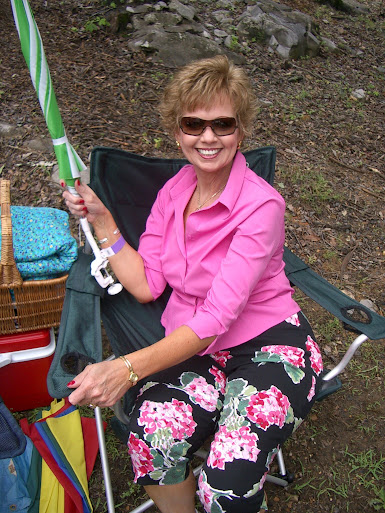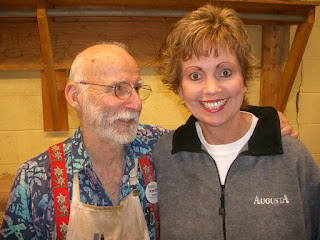On Monday, I said goodbye to my bride of 17 years, Mary Ann. The only saving grace was that she had suffered for more years than I care to remember the painful effects of fibromyalgia, polymyalgia rheumatica, osteoporosis, and other pain-inducing maladies. Her suffering was extreme and constant. She is truly in a far, far better place.
Mary Ann Lau and I met in 1984, not long after I had found sobriety and began working in the aerospace industry at John M. Cockerham and Associates in Huntsville, Alabama. She was hired to be an executive assistant to Charles Stroud, a senior vice president of the firm. Lau was the name of her first husband, Peter, from whom she had been divorced for a few years. She chose not to return to her maiden name, which had been Allard. She was regal is her poise and stature, always made a fashion statement, and was rarely on time. Charlie overlooked the lateness because Mary Ann was beyond competent. She was obsessive-compulsive in everything she did, an absolute perfectionist. Soon, she was put in charge of arranging travel for everyone in a company of nearly 100 employees who traveled a lot. Even that job didn't phase her. She performed it with ease.
Cockerham was a unique company. It had the feeling of a closely-knit family. Employees went out of their way to help and support one another. This camaraderie was reflected in a weekly Friday evening happy hour, at which Mary Ann could be counted upon to make an appearance. And often, she embarrassed herself with her excessive well-lubricated enthusiasm.
I had become a recovering alcoholic only a few months before we met. In the glow of my newly-found sobriety, I was out to save the world. After hearing stories of Mary Ann's performances at the happy hour events, I concluded that she might have "a problem." One day I appeared at her desk with a paperback copy of the AA "Big Book." I suggested to Mary Ann that she might benefit from reading it. (This is not, by the way, a technique recommended by AA or any of its affiliates!) I was told in no uncertain terms where I might insert my book.
In this part of the country, most AA groups offer a white poker chip to newcomers who want to follow a new path. Usually there is the suggestion that "If you feel like taking a drink, put this on your tongue and let it dissolve first." It was only a few years later, in January of 1988, that Mary Ann walked into my cubicle and showed me her new white chip. Miraculously, she had been both a crack cocaine addict and an alcoholic, but never drank or drugged after that date. She became a changed person.
Mary Ann decided she needed a decent, clean-cut man friend. Somehow, she heard that Whitesburg Baptist Church had a singles club, and she got religion. She began attending Whitesburg Baptist Church, then pastored by Brother Jimmie Jackson. She received religious instruction, got involved in a women's bible study group, and was baptized all within a year of her sobriety. She remained a bible-believing Christian the rest of her life. When Mary Ann passed away, she was only a couple weeks away from her 33rd sobriety birthday.
Mary Ann and I had stayed casually in touch over the years that she returned to her home state of Iowa. We would exchange Christmas cards and an occasional birthday note (She was a Christmas baby.). A few months after I lost my first wife, Margo, to ovarian cancer, I heard a rumor that Mary Ann Lau was back in Huntsville. Within a few weeks, I got a phone call from Mary Ann asking if she could use me as a reference as she sought employment. I of course agreed and wrote a glowing recommendation based on her performance at Cockerham and Associates. We met for lunch and I gave her the letter.
Only a few weeks later, I had tickets to a Huntsville Chamber Music Guild concert to be performed by Chanticleer, a San Francisco-based men's choral group of fabulous talent. Not wanting to waste a ticket, I called Mary Ann to see if she'd care to accompany me to the concert. She accepted and we went out to dinner, then to the concert, followed by dessert at a small German restaurant known for their desserts.
I found out later that Mary ann had called a dear friend and counselor in Iowa the next day. She recounted to Joyce the details of the night before and then asked, "Do you think that was a date?" Her friend responded, "Mary Ann, did you shave your legs?" When Mary Ann responded in the affirmative, she was assured that it had indeed been a date.
We began seeing each other regularly and were soon engaged. Our engagement party was in the same Italian restaurant where we had gone on that first date. Charlie Stroud and his wife Brenda and two dear friends, Monty and Dinah Love, were in attendance.
Mary Ann had remained friends with her first husband, Peter Lau and his lovely wife, Ronelle, who live in Davenport, Iowa. When Pete and Ronelle found out that we were engaged, they invited us to Iowa to celebrate with them. We flew to Davenport and enjoyed a wonderful weekend with family and friends, including a memorable barbecue at a small cabin on a little lake that is located on the Lau homestead farm. What wonderful memories that weekend produced.
On July 30, 2004, we celebrated our marriage in a private ceremony at the First Christian Church, Disciples of Christ, in Huntsville. The presiding minister was the Rev. Dianne Wood, who knew Mary Ann from her early days at Whitesburg Baptist, when Mary Ann had started a 12-step ministry for Christian women. And our friend Monty Love, a former lay minister, assisted Dianne. It was a very special day.
I continued working in the aerospace industry and Mary Ann did as well until around 2006. She had a lifelong dream of having her own gift shop. Quite unexpectedly, the property adjacent to our home became available and I was able to purchase it. Ebabe's Gifts was about to become reality. Mary Ann had already started a gift shop on Ebay and it was doing quite well. We decided to go ahead an build a brick-and-mortar store on the newly acquired real estate. She was like a kid in a toy store. She got all her necessary licenses and permits and bank accounts, decorated and equipped the new building, and we had our first experience with the wholesale gift market in Atlanta. The store opened on October 18th, 2008, just in time for the Christmas season.
Saturday mornings were like social hours, with abundant baked goods and beverages. Hot spiced cider filled the store with holiday aromas during the winter months.
Then came the day in 2013 when Mary Ann's pain became too much to continue to operate the store. We had one blowout sale and closed the door.
After its closing, Mary Ann rarely spoke about the store. A major part of her life had been cruelly ended. The loss affected her deeply. Her will to live suffered.
We spent lots of time engaged in doctors' visits as Mary Ann's ailments progressed. She reluctantly accepted the use of a walker, then a wheelchair. Her pain medication became less effective and her life more tortured. Stints in rehab seemed to be of little benefit.
After several falls, we ended up in the Columbia Regional Medical Center, where she spent her last days. Her cause of death was officially listed as congestive heart failure. She maintained a deep and abiding faith in a loving God up to the very end.
I miss her more than I can express.




















 The man emerged and greeted me with a cigarette locked between his lips, "I sure am, and who are you?" This began a friendship that would last many years. He admired my car, asked how long I had owned it, told me that the early Plymouths were fine machines, and agreed to help me maintain it. He was amazed that I had chosen to drive the car halfway across the country.
The man emerged and greeted me with a cigarette locked between his lips, "I sure am, and who are you?" This began a friendship that would last many years. He admired my car, asked how long I had owned it, told me that the early Plymouths were fine machines, and agreed to help me maintain it. He was amazed that I had chosen to drive the car halfway across the country.

